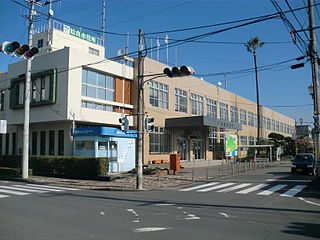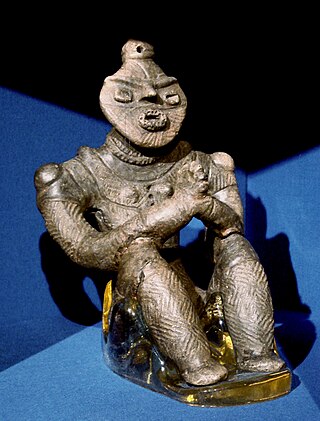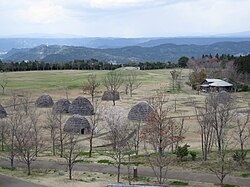
Aira is a city located in Kagoshima Prefecture, Japan. It is located west of Kirishima and north of Kagoshima.

Yūsui is a town located in Aira District, Kagoshima Prefecture, Japan.

Jōmon Prehistoric Sites in Northern Japan (北海道・北東北の縄文遺跡群) is a serial UNESCO World Heritage Site consisting of 17 Jōmon-period archaeological sites in Hokkaidō and northern Tōhoku, Japan. The Jōmon period lasted more than 10,000 years, representing "sedentary pre-agricultural lifeways and a complex spiritual culture of prehistoric people".

Kirishima Open Air Museum opened in Yūsui, Kagoshima Prefecture, Japan, in 2000. Located in the foothills of Mount Kirishima, at an elevation of seven hundred metres above sea level, the Museum encompasses an area of 20 hectares. Works are displayed in the open air as well as in the Art Hall.

The Togariishi Museum of Jōmon Archaeology is a municipal museum located in the city of Chino, Nagano Prefecture, Japan, specializing in artifacts of the Jōmon period.

The Korekawa Site is an archaeological site in the city of Hachinohe, Aomori Prefecture, in the Tōhoku region of northern Japan containing the ruins of a middle to late Jōmon period settlement. The remains were designated a National Historic Site in 1957 by the Japanese government. It is also referred to as the "Korekawa Stone Age site", although the remains discovered are from the Jōmon period, rather than the Japanese Paleolithic period.

The Mawaki Site is an archaeological site with the ruins of a Jōmon period settlement in the Mawaki neighborhood of the city of Noto, Ishikawa in the Hokuriku region of Japan. The site was designated a National Historic Site of Japan in 1989.

Hakodate Jōmon Culture Center opened in Hakodate, Hokkaidō, Japan in 2011. It has four exhibition rooms dedicated to the Jōmon period, displaying some 1,200 pieces of earthenware and stoneware excavated in Hakodate as well as the only National Treasure in Hokkaidō, the so-called "Hollow Dogū", excavated from the Chobonaino Site. Hands-on activities, including magatama-making and "angin-knitting", are also available. The museum is located at Michi no Eki Jōmon Roman Minamikayabe, making this the only roadside station in Japan with a museum with a National Treasure.

Korekawa Archaeological Institution , more literally the Hachinohe City Buried Cultural Property Center, opened in Hachinohe, Aomori Prefecture, Japan in 2011. It exhibits Jōmon materials from the nearby Korekawa Site and Kazahari I Site (風張1遺跡), finds at the latter including the "Palms Together Dogū" (合掌土偶) that has been designated a National Treasure.

The so-called "dogū with palms pressed together" is a Japanese dogū or clay figurine of the late Jōmon period. Excavated from the Kazahari I Site in Hachinohe, Aomori Prefecture, it is exhibited at the nearby Korekawa Jōmon Kan. Alongside "Hollow Dogū" from Hokkaidō, "Jōmon Goddess" from Yamagata Prefecture, and "Jōmon Venus" and "Masked Goddess" from Nagano Prefecture, it is one of five dogū that have been designated National Treasures.










